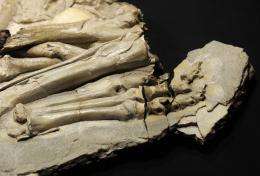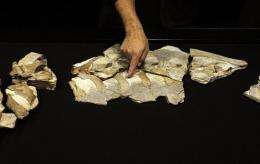Dinosaur trove spills more secrets

Decades after a mechanical pine-tree digger first unearthed it, an extraordinary trove of dinosaur fossils in central Spain is revealing its secrets.
When the digging machine cut a furrow to plant pines in the arid soil near the medieval town of Cuenca in the 1980s, it sliced through more than 100 million years to one of Europe's richest seams of fossils.
It was a fluke that opened the way to a series of discoveries about the creatures that walked our planet in the Cretaceous period, between 65 and 145 million years ago.
The latest secret: a strange hump-backed dinosaur, fossilised after it had devoured its prey about 125 million years ago.
Six metres (20 feet) long from snout to tail tip, the dinosaur had jaws and small, clawed forelimbs, a curved spine and small hump.
Pepito, as the creature has been nicknamed by the team from Autonomous University of Madrid who dug it out, was a fast and powerful hunter.
And it had apparently eaten recently.
The unique, nearly complete fossil contained the remnants of its prey in the abdominal cavity.
Baptized Concavenator corcovatus (from "Conca", the Latin word for Cuenca; "venator", for hunter; and "corcovatus", or hump-backed) the fossil this month joined the rich collection of Cuenca's regional science museum.
The number of visitors has jumped 70 percent and the number of hits on the museum Internet site has exploded since the discovery was published in Nature, said museum director Jesus Madero.
Pepito "is a strange beast, a strong runner on small feet," said palaeontologist and co-author of the Nature article, Francisco Ortega.
Its hump had never been seen before in dinosaurs, said the professor at UNED, the Spanish Open University for distance learning. Set above the hind legs area, it could have served as an energy reserve as in a dromedary, he said.
It is not the first time that this fossil seam in Las Hoyas, discovered by chance, has delivered up an important part of the pre-historic history of the planet.

A missing link between dinosaurs and birds, Iberomesornis, an unusual little bird with a beak and very probably teeth, was found in the same formation in the 1980s, "at a time when we were in the midst of the debate over whether birds descended from dinosaurs," Ortega said.
In fact, the area around Cuenca seems to be rich with pre-historic evidence. Not far away is a site where fossilised dinosoar eggs were unearthed.
In 2007, a new seam was discovered a few kilometres (miles) farther south, during works to build the Madrid-Valencia high-speed train line.
An impressive collection of crocodiles, tortoises and dinosaurs from the upper Cretaceous period was brought to light, with about 20 remains of large herbivores, sauropods previously unknown in this part of Europe.
This immense collection of 8,000 pieces now sleeps in boxes in an anonymous warehouse outside of Cuenca because there is no space in the museum.
It may yet live again with a plan to build a palaeontology institute accompanied by a museum and theme park near the discovery in Fuentes. But the regional government of Castile-la Mancha has been forced to shelve the project temporarily because of the economic crisis.
If it sees the light of day, it could rival Dinopolis, a theme park 150 kilometres (90 miles) northeast in Teruel, which has drawn 1.5 million visitors since 2001.
Located on the same seam, Cuenca and Teruel are friendly rivals: a few days after the discovery of Pepito, Teruel announced it had unearthed the largest dinosaur femur bone ever discovered in Europe.
(c) 2010 AFP












.jpg)





